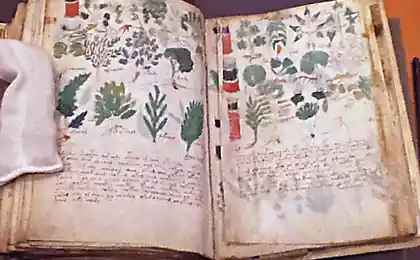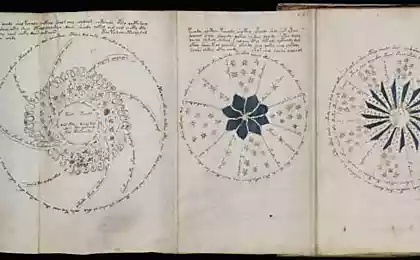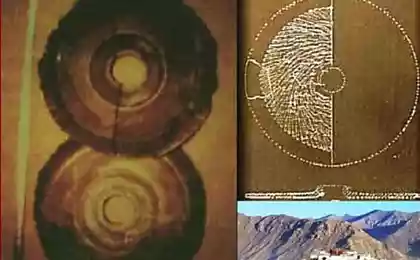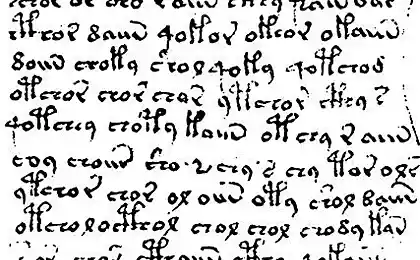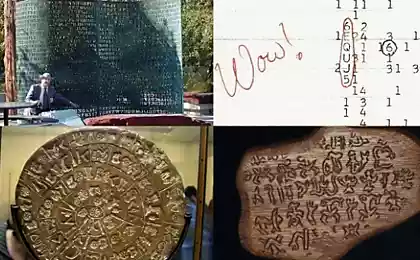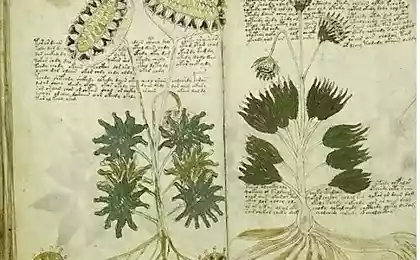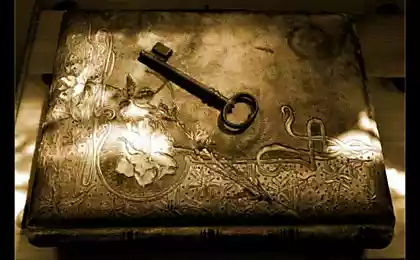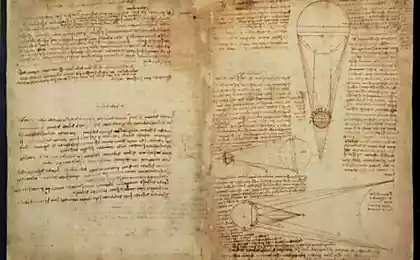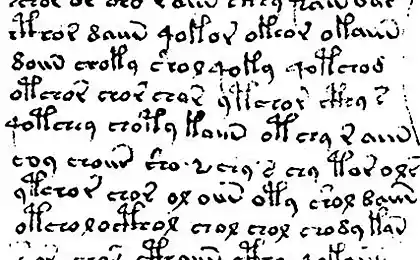9457
Voynich manuscript. The Manchurian Candidate
Манускрипт Voynich (MW or VMS) is called the Holy Grail of cryptography. For several hundred years, thousands of man-days were spent and continue to spend money in an attempt to unravel its meaning and translation. And people have tried very different, including the world's foremost cryptographers. While that is not very. Two slightly hundreds of pages of parchment, an unknown alphabet, unknown language, calligraphy confident handwriting, drawing dozens of unknown plants and naked women bathing in a strange channels zodiac astrological charts - set of clues, but nothing that would decipher the manuscript. For anyone who has ever tried a little porazgadyvat hooks, CF seems perfect puzzle - has no clue yet known.
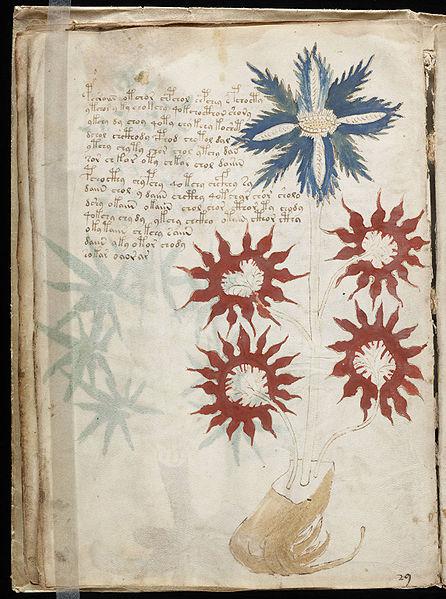
page 16v h6>
The Count of statistical coherence between parts of the manuscript - picture from the article Montemurro h6>
A short note on the Manchu language. h5>
Description of the method h4>
Alphabet and broadcast h5>

page 16v h6>
I saw a few months ago post Habré about the Aztec language and botanists have recognized the several Central American plant, but still fetch from drafts their records. Their goal - to acquaint readers with the world razgadyvateley VMS, and my not very in-depth analysis of one of the relatively recent hypotheses - about the Manchu language manuscript.
Walk through the high-resolution scans here: Voyage the Voynich Manusript
For the first time I met with CF from old article in the paper Computerra, but a little exercise they wanted now, after the interview Heathcliff the author of the latest study Marcelo Montemurro, опубликованным on PLoS One . I advise you to read the articles in Wikipedia and Computerra and interviews on tape.
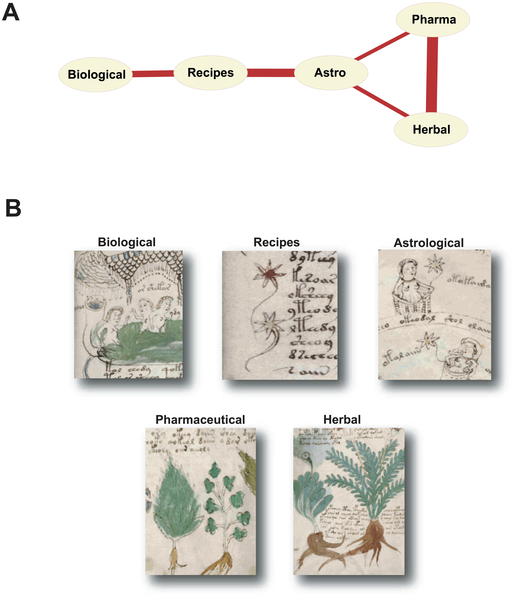
The Count of statistical coherence between parts of the manuscript - picture from the article Montemurro h6>
Over the history of the manuscript appeared solving a lot of hypotheses about its language - from the European one (or mixtures thereof), and the Middle East to quite rare and distant, or the type of Old Indian, native to Europe that the 15th century had no contact; not without a перевода with old Ukrainian. One of the latest "breakthrough" the beginning of the year - a transcript dozen words the British linguist Stephen Bax and attempt to tie some pictures and captions Central American endemic and indigenous languages. Also, a lot of researchers have despaired and decided that the text - a fake or nonsense, gibberish, created to fill the mist, or hit the shoppers. Yet those who believe that the CF - real ciphertext - a lot more. There are reasons to believe that this is the case:
1. The presence of the complex structure of the text. Like all real languages, CF is subject to закону Zipf , ie word frequency is inversely proportional to its serial number in the sorted sequence frequency.
2. Entropy characteristics of the text is close to the European languages - Latin, English
I remember in one of his autobiographical book by Richard Feynman described his analysis album sheets supposedly unknown books c Maya hieroglyphs. In the story pretty quickly Feynman managed to split forgery by means of statistical evaluation and logical reasoning. Then he enthusiastically fantasizing - it would be great if someone decided to create a really cool fake, taking into account all the laws of such texts. If someone had such a failed fake - it's MV.
In 2003-2004, a Polish researcher, Zbigniew Banasik (Zbigniew Banasik) offered Manchurian version. References to it, but his letter of Voynich, I did not find, but for this article found in the publication польской newspaper . Google gives translation, is an amateur linguist and polyglot from the village at Wroclaw ... He suggested translation of the manuscript in the Latin alphabet and gave an initial interpretation of the first page. The first page of the manuscript 1r - one of the main goals of the attacks on VMS, it is believed that having solved at least part of it, you can get the keys to the entire manuscript.
A short note on the Manchu language. h5>
There are статья Russian Wikipedia. In short, the Manchus - the people who lived in the northern part of modern China and some Far Eastern Russia, a native of Baikal and the Altai. A more ancient name - Jurchens. In the 17th century, China was attacked and captured, burned Shaolin and founded the Qing dynasty, which ruled until the early 20th century. During this period, China's official document was conducted in manchzhurskom language in the Chinese archives accumulated kollosalnoe number of documents to which researchers have not reached your hands. It is believed that a good historian and sinologist must master the Manchu at least in order to read the most important documents in the original era. With the 17th century at the Manchu was the original alphabet , but then they switched to Chinese characters. The Chinese are highly developed language of the conquerors, adding a set of words translated into manchursky Tao Te Ching and the military treatise Sun Tzu, and in the late 19th century, successfully assimilated Manchuria. Now almost all the Manchus speak Chinese with the exception of a small isolated nation Sibo . Already in the late 19th century, the Manchu language was considered an endangered now it can be considered almost dead.
Historically, Russia XIX century. It has developed a powerful manchzhurovedov school, which, as they say, has handed in the XX century because of wars and revolutions. The network scan can be found in pdf deeply researched "Complete Manchu-Russian dictionary» I.I. Zakharova publication in 1875, but in this case it is more convenient to use digitized Manchu-English dictionary Dzh.Normana . Here you can listen to the song with a Latin ARKI UCUN pony. As I understand it, the name is translated like "let's drink" or something similar.
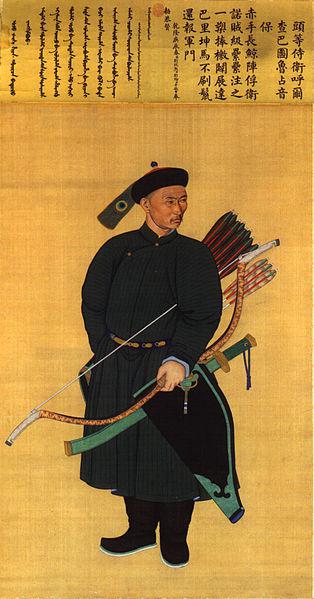
The Manchurian officer of the Qing Dynasty, the late 1700s, the picture of the Википедии
Description of the method h4>
Alphabet and broadcast h5>
Anyway, I took a lot of work to be done William Porquet. On his page has a great post A Manchu Skeleton Key to the Voynich Manuscript . On the main page there are no references to it, but it is Google, and I also found a lot of interesting the root web directory , where It is an article. He also left a link to an article on the different forums voynichevedov.
So, taking the alphabet Banasik and its extension, which offered Porquet, you can translate the text of the manuscript in a few versions of the text in the Latin alphabet with a small number of additional letters. Then moving on the assumption that we have a text in Manchu language, or one of its dialects - extinct or mixed with additional words from another language, we can try to get a translation of each word and phrase of several words. One of the main assumptions is that the words were written at the hearing or the person speaking the language without a deep knowledge of grammar and spelling - if any was at the time of creation. This means that a single word can be written in several similar versions. This is supported in particular common end ain, aiin, aiiin, daiin, and so on. notation EVA ( European Voynich Alphabet i>).
First I created a framework for text analysis. For several reasons, it was chosen Oracle 11g. Oracle is mentioned because that will provide examples of queries his version of SQL. With scripts you can find in the repository Github. It is laid out a set of scripts that create charts, tables and a number of DML SQL script, filling the data table of the manuscript, Manchu-English dictionary and some others.
So, a simple sequence of regular expressions from the text of the manuscript records in EVA and expanded alphabet Banasik get scripts that import VMS row where the index line looks like
& lt; page_numberSIDE_LETTER.row_number & gt; pre>. For example, the second line of the first page of the manuscript has an index of
& lt; b & gt; & lt; 1r.2 & gt; & lt; / b & gt; pre>:
The first 2 lines VMS notation EVA look like this (taken from www.voynich.nu/analysis.html ):
fachys.ykal.ar.ataiin.Shol.Shory.cThres.y, kor.Sholdy
sory.cKhar.or, y.kair.chtaiin.Shar.are.cThar.cThar, dan
The broadcast will look like this:
'& lt; 1r.1 & gt; ',' Fachys.ykal.ar.ataiin.Shol.Shory.cThres.y, kor.Sholdy ' code> pre>
'& lt; 1r.1 & gt; ',' Cušil i cum us uhungg tom tosi jolkl i cos tombi ' code> pre>
'& lt; 1r.2 & gt; ',' Sory.cKhar.or, y.kair.chtaiin.Shar.are.cThar.cThar, dan ' code> pre>
'& lt; 1r.2 & gt; ',' Losi gus os i cuks šhungg tus url jus jus bug ' code> pre>
Signed at the end of the fifth row of the first section ydaraiShy is converted to ibusurti
Comparison of similarity functions h5>
Words and phrases translated table of VMS in the Latin alphabet, need to be compared with the words of Norman dictionary. One entry in the dictionary contains a single word or phrase of several words in capital letters Manchu and their English translation, which can have several meanings. For example:
CŪŠILE crystal
NIYOHOMBI to have sexual intercourse
In CŪŠILE broadcast the first word fachys i> the first page of 1r , the second repeatedly flashes in the manuscript, including grammatically correct decline in Manchu. The same word is convenient to show additional letters: C sounds like a hard "h», Š - as "w», Ū - roughly as "th».
Comparison of similarity functions h5>
Words and phrases translated table of VMS in the Latin alphabet, need to be compared with the words of Norman dictionary. One entry in the dictionary contains a single word or phrase of several words in capital letters Manchu and their English translation, which can have several meanings. For example:
CŪŠILE crystal
NIYOHOMBI to have sexual intercourse
In CŪŠILE broadcast the first word fachys i> the first page of 1r , the second repeatedly flashes in the manuscript, including grammatically correct decline in Manchu. The same word is convenient to show additional letters: C sounds like a hard "h», Š - as "w», Ū - roughly as "th».
SOUNDEX h6>
To begin to index and match the dictionary and I took the manuscript procto function SOUNDEX. It is the oldest phonetic algorithm established already in 1918 and in my opinion was used before computers at the US Census. By creating a dictionary in the table and the table that stores the dictionary fragments of manuscripts, columns index SOUNDEX, you can see it on translations.
Unfortunately, SOUNDEX raking in too much excess. He takes the first 2-3 syllable of the word translates from alphanumeric code, where a group of similar sounds (ie the letters) are translated into a single character. More - in the above link to the wiki. But it offers translations into English! This is the first approximation, and it is very important.
SOUNDEX h6>
To begin to index and match the dictionary and I took the manuscript procto function SOUNDEX. It is the oldest phonetic algorithm established already in 1918 and in my opinion was used before computers at the US Census. By creating a dictionary in the table and the table that stores the dictionary fragments of manuscripts, columns index SOUNDEX, you can see it on translations.
Unfortunately, SOUNDEX raking in too much excess. He takes the first 2-3 syllable of the word translates from alphanumeric code, where a group of similar sounds (ie the letters) are translated into a single character. More - in the above link to the wiki. But it offers translations into English! This is the first approximation, and it is very important.
METAPHONE h6>
Development of phonetic algorithms led to the creation Metaphone and later - Double Metaphone. This is a more advanced version of the comparison of words. Instead alphanumeric code of a word or phrase is calculated purely alphabetic code, given to one case. Normally, vowels removed, steam or similar consonants collapsed into a single representative. All spacers and non-alphanumeric characters are ignored. Metaphone appeared at the border of 80s-90s, Double Metaphone - in the mid-90s, Metaphone 3 - in 2009. The latter is a commercial software is sold with a small base for comparison of names, written in English. There implementing Double Metaphone for different languages, taking into account the pronunciation in these letters and letter combinations. There and Russian. For Manchurian not. I found the free exercise Double Metaphone on PL / SQL, and slightly expanded it by adding the above letter and a couple more of these. The repository available, there are literally a few lines changed. Yes, the morphology of the language, with all declensions, suffixes and prefixes it does not catch, but even that turned out - very interesting.
Compound table with cutting-word manuscript and Manchu dictionary on the field code METAPHONE (MPH_CODE) through LEFT JOIN.
The following table shows the translations of the first line of the first page & lt; 1r.1 & gt; . Most of the words have several options, but the word 5 ( uhungg i>) and 8 ( jolkl i>) of no.
METAPHONE h6>
Development of phonetic algorithms led to the creation Metaphone and later - Double Metaphone. This is a more advanced version of the comparison of words. Instead alphanumeric code of a word or phrase is calculated purely alphabetic code, given to one case. Normally, vowels removed, steam or similar consonants collapsed into a single representative. All spacers and non-alphanumeric characters are ignored. Metaphone appeared at the border of 80s-90s, Double Metaphone - in the mid-90s, Metaphone 3 - in 2009. The latter is a commercial software is sold with a small base for comparison of names, written in English. There implementing Double Metaphone for different languages, taking into account the pronunciation in these letters and letter combinations. There and Russian. For Manchurian not. I found the free exercise Double Metaphone on PL / SQL, and slightly expanded it by adding the above letter and a couple more of these. The repository available, there are literally a few lines changed. Yes, the morphology of the language, with all declensions, suffixes and prefixes it does not catch, but even that turned out - very interesting.
Compound table with cutting-word manuscript and Manchu dictionary on the field code METAPHONE (MPH_CODE) through LEFT JOIN.
The following table shows the translations of the first line of the first page & lt; 1r.1 & gt; . Most of the words have several options, but the word 5 ( uhungg i>) and 8 ( jolkl i>) of no.
'& lt; 1r.1 & gt; ',' Fachys.ykal.ar.ataiin.Shol.Shory.cThres.y, kor.Sholdy ' code> pre>
'& lt; 1r.1 & gt; ',' Cušil i cum us uhungg tom tosi jolkl i cos tombi ' code> pre>
N - number of words in a line & lt; 1r.1 & gt;
NWORD - words into sentences alphabet
MPH_CODE - metafonovsky code word NWORD
WORD - option Manchu dictionary words Norman, who metafonovsky code is the code of NWORD
TRANSLATION - Manchu word translation
N th> NWORD th> MPH_CODE th> WORD th> TRANSLATION th > 1 cusil CSL CUSILE crystal 2 i I I 1. he, she 2. the genitive particle 3. an interjection used to get the attention of subordinates 2 i I IO oil, paint, lacquer 2 i I II see ii 2 i I < / IOI 1. a musical instrument made in the shape of a lying tiger - the toothed ridge down the back is stroked with a wooden stick at the conclusion of a musical selection 2. one of the five tones; cf. yumk'a 2 i I II 1 . (onom.) the sound of sobbing 2. an interjection of derision 3 cum CM < CIME a salt-water fish resembling the salmon 3 cum CM < / COMO see coman 4 us US td > USE seed, egg (of an insect) 4 us US UCE door 4 us US USA exclamation used to get someone's attention 5 uhungg < / 6 tom TM TOOME see tome 6 tom TM TOMOO frame used for weaving nets 6 tom TM TIMU topic, theme 6 tom TM TOME (postposition) every, each 6 tom TM TAMA sole (fish) 7 tosi TS TEISU 1. assigned place, designated place, responsibility, one's part 2. corresponding, matching, facing, opposite 7 tosi TS TESU original, local 7 tosi TS < / TOOSE 1. weight (for a balance) 2. power, authority, right 3. spindle 7 tosi TS td > TOSE see toose 7 tosi TS < TESE plural of tere: those, they 7 tosi TS TES (onom.) the sound of rope, thread, or a leather thong breaking under stress 7 tosi TS TOSI white spot on the forehead of an animal 7 tosi TS TSU vinegar 7 td > tosi TS TUSA profit, gain, benefit, advantage 7 tosi TS TUSY chieftain of a native tribe 8 jolkl 9 < i I II see ii 9 i I IOI 1. a musical instrument made in the shape of a lying tiger - the toothed ridge down the back is stroked with a wooden stick at the conclusion of a musical selection 2. one of the five tones; cf. yumk'a 9 i I II 1 . (onom.) the sound of sobbing 2. an interjection of derision 9 i I < IO oil, paint, lacquer 9 i I I 1. he, she 2. the genitive particle 3. an interjection used to get the attention of subordinates 10 cos CS CECE silk gauze 10 cos CS CASI in that direction, thither, there 10 cos CS CESE register, official record 10 cos CS CISE vegetable or flower garden 10 cos CS CAISI see caste 10 cos CS < / CISU private, private interest or profit 10 cos CS CISUI out of one's own interest, on one's initiative, naturally (see also ini cisui), privately, on one's own 10 cos CS COS the sound of ricocheting or rebounding < 10 cos CS CUSE 1. bamboo 2. silk 3. a cook 10 cos CS CAISE td > 1. hairpin 2. a cake made of fried vermicelli 11 tombi TMB TUMBI to hunt, to pursue 11 tombi TMB TOOMBI < / to scold, to rail at, to abuse, to curse 11 tombi TMB < / TEMBI 1. to sit 2. to reside, to live 3. to occupy (a post) 11 tombi TMB TAMBI 1. to get caught on something, to get entangled and trip over something 2. to get caught in a trap or net 11 tombi TMB TUMBI to hit, to beat, to pound; cf. dumbi 11 tombi TMB TOMBI see toombi < /
As you can see, some words are similar in appearance, some are spaced too far, because of the almost complete cut vowels from a word in the code are given all options Manchu words that have between consonants very different vowels. Short one- and two-letter word - even "the mark". But it is interesting - much more interesting than to look in the dictionary manually with Ctrl-F.
Total metaphone used three versions - the original English and two modified with additional letters and change the rules of the convolution.
Shipments to the synonyms in the translation field h5>
Small correction of a dictionary - to the field of translation, contains forward «see SOME_OTHER_WORD» through a separator is added to the translation of a synonym.
Shipments to synonyms caught a regular expression.
For example in the above table:
TOSE see toose
soon complemented transfer links:
TOSE see toose :: 1. weight (for a balance) 2. power, authority, right 3. spindle
Shipments to the synonyms in the translation field h5>
Small correction of a dictionary - to the field of translation, contains forward «see SOME_OTHER_WORD» through a separator is added to the translation of a synonym.
Shipments to synonyms caught a regular expression.
For example in the above table:
TOSE see toose
soon complemented transfer links:
TOSE see toose :: 1. weight (for a balance) 2. power, authority, right 3. spindle
Morphology. Declension of verbs at times h5>
Go ahead. You can immerse yourself in the language deeper. Verbs in Manchu bow at the end of the time of addition. That here is a table with examples of declinations and corresponds to the English times. You may notice that one or the English Present Continious Past Continious there are several different versions of the Manchu. Perhaps they reflect some subtleties incomprehensible to me or is it just synonyms, but to match in the Voynich is not important. Because dictionary tables do and keep the sample in the form of the infinitive verbs - that is, all the words ending in infinitive ending -MBI and having a substring in the translation field & quot; to & quot ;.
Example.
Списки
Критика
Hoaxing
Hoaxing
Первые
Отзыв
Google
href="http://ru.wikipedia.org/wiki/%D0%A7%D0%B6%D1%83%D1%80%D1%87%D0%B6%D1%8D%D0%BD%D1%8C%D1%81%D0%BA%D0%BE%D0%B5_%D0%BF%D0%B8%D1%81%D1%8C%D0%BC%D0%BE">Чжурчжэньское letter.
Retouching
Маньчжурские
Morphology. Declension of verbs at times h5>
Go ahead. You can immerse yourself in the language deeper. Verbs in Manchu bow at the end of the time of addition. That here is a table with examples of declinations and corresponds to the English times. You may notice that one or the English Present Continious Past Continious there are several different versions of the Manchu. Perhaps they reflect some subtleties incomprehensible to me or is it just synonyms, but to match in the Voynich is not important. Because dictionary tables do and keep the sample in the form of the infinitive verbs - that is, all the words ending in infinitive ending -MBI and having a substring in the translation field & quot; to & quot ;.
Example.
Списки
Критика
Hoaxing
Hoaxing
Первые
Отзыв
Google
href="http://ru.wikipedia.org/wiki/%D0%A7%D0%B6%D1%83%D1%80%D1%87%D0%B6%D1%8D%D0%BD%D1%8C%D1%81%D0%BA%D0%BE%D0%B5_%D0%BF%D0%B8%D1%81%D1%8C%D0%BC%D0%BE">Чжурчжэньское letter.
Retouching
Маньчжурские
"Dauria" in space
Summary of the Soviet space exploration, types of rockets and the most significant victories in this field. Part 2



